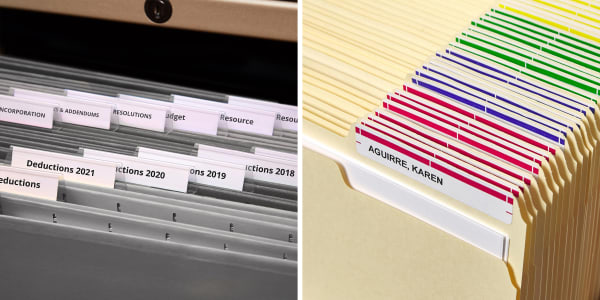
Records Management: Life Cycle Best Practices and FAQs
Estimated reading time: 9 minutes
Increase compliance and efficiency, reduce risk and protect data
While digital records and cloud-based file storage are becoming the norm for many businesses, there are still many records that need to be kept physically. Keeping physical records of articles of incorporation, minutes from annual shareholders meetings, accounting records and human resources files can help protect your team and is required by law in many cases.
Along with the legal requirements, there are a variety of reasons why physical records need to be kept around, at least for a time, and accessed. It’s important to store and maintain your records safely and intelligently for the following reasons:
- Compliance – Government inspections and audits will require certain documents and not having them kept for the proper amount of time can incur penalties.
- Efficiency – A well-organized system makes it easier to pull records for reference without slowing down productivity.
- Risk Reduction – In the event of a lawsuit or an internal investigation, having well-documented files can provide valuable evidence.
- Data Protection – Ensure that the personal and/or proprietary data of your team and your company is both kept safe and then appropriately disposed of when no longer needed.
When applied efficiently, good record management can help make your company more efficient, prepared and safe. Our overview will help you walk away with a better understanding of what is involved in records management, the 4 life cycle stages of records and answers to important FAQs.

What is records management?
Records management, also referred to as records and information management, is an organizational function that manages the information in your company. According to the International Organization for Standardization, (ISO) 15489-1:2016, managing records includes:
- Creating and capturing records to meet requirements for evidence of business activity.
- Taking appropriate action to protect their authenticity, reliability, integrity and useability as their business context and requirements for their management change over time.
The responsibilities of records management also involve tracking a record through its entire life cycle. The life cycle of a record includes classifying the record when it is created, knowing how to store the information, being able to retrieve information when needed and knowing when records need to be eliminated or permanently archived.
Records can be stored digitally, physically or through some combination of both, depending on the type of record being stored. For example, records of e-mail exchanges should be kept in a digital format since it contains important metadata that gets lost when it is simply printed out. On the other hand, something like a signed contract should be kept in its original physical form since a digital version could be altered.
Records management vs. Document management
In order to understand the difference between records management and document management, it’s important to know the difference between a record and a document. A record is a specific document or piece of evidence that tracks certain events that happen in your organization.
However, not all documents can be considered records, just specific types of documents that provide proof of an event. As a result, records management is focused on the preservation and maintenance of records while document management works toward streamlining the access and location of documents in general.
While document management is focused on the day-to-day capture of information with the goal of efficiency in mind, records management establishes policies and standards for maintaining diverse types of records within the guidelines of the law. In short, document management works towards efficiency, but records management works towards efficiency as well as compliance.

What is the purpose of records management?
The purpose of records management is to properly catalogue the records of your organization so that the information can be easily and efficiently retrieved when needed. This is useful in the event of a workplace dispute, a lawsuit or an audit but in some cases it is a legal requirement. Here are the four main goals for records management:
Compliance
If your company undergoes a government inspection or an audit, there can be penalties if your organization did not retain the correct records. Some organizations create their own helpful guidelines for records retention but make sure to check your local legal and regulatory requirements for more information.
Efficiency
Records can quickly stack over time but a smart system can help you easily find your files and avoid digging through years of documents. An efficient records management system will include an intuitive classification system but will also take into account the physical footprint of your records.
Survey the space in your organization to decide on the shelving, drawers, binders or other supplies and equipment that is needed to make the best use of the storage space. Also make sure that your drawers and shelves are easily customizable so that they can be readjusted over time.
Risk Reduction
If your organization ever goes to court, accurate recordkeeping can be a windfall for locating specific information. A good corporate policy for records retention can ensure the integrity of your records and provide valuable evidence when needed. This also encourages healthy transparency and accountability of your company’s information.
Data Protection
Records can hold sensitive information, both personal and proprietary, and proper records management can make sure that this data is kept safe or properly erased when needed. This is also related to regulatory compliance since some laws, such as the recordkeeping requirements of the U.S. Equal Employment Opportunity Commission, require that employers keep personnel and employments records for one year.
4 stages of the records management life cycle
There are four basic stages in the life cycle of a record: Identify, store, track and dispose. Here are a few tips and things to keep in mind for each stage.
1) Identification: When does a document or data become a record?
According to ISO 15489-1:2016, a record is “information created, received and maintained as evidence and as an asset by an organization or person, in pursuit of legal obligations or in the transaction of business.” For example, reasons for why a document can be considered a record can include:
- Legal requirements
- Requirement for future planning and business continuity
- Establishing responsibility and evidence for potential case disputes
- Historical value
2) Storing: Consider space, security and document integrity
Not all records are equal and some will need to be stored more securely than others. For example, the medical information of your employees are confidential and should be kept separately from other employee records. Also, if your business has archival needs, make sure that the records that you are keeping permanently are kept at the correct temperature and humidity.
You might also want to organize your records based on how often they are accessed. Using data storage as an example, data can be organized as cold or hot depending on how often they are needed. With this method, you can keep your cold data in stacked boxes and then have your hot data in binders on a shelf for easy access.
3) Tracking: Locate records at every stage of the life cycle
While some records will need to be kept physically, that doesn’t mean you can’t use digital methods to track them. Asset tags with barcodes make it easy to scan your boxes of documents into data management programs so that you can filter and search for specific files.
Tracking your records digitally also makes it much simpler to keep track of where certain records are in their life cycles. With the right software, you can receive alerts or pull reports to see which files need to be destroyed and when.
4) Disposal: Approval, retention periods and proper disposal methods
One of the most common concerns with records management is how long records need to be kept. This can be a difficult question to answer since the right choice can vary depending on your business, the types of records being stored and local laws.
Referencing existing records retention guidelines from other organizations can be a good start. For example, the Illinois CPA Society (ICPAS) records retention guidelines provide a helpful list of retention periods for various different types of records and documents. However, these guidelines can rarely be copied and pasted wholesale and we would highly recommend conducting your own research and consulting your legal counsel.
Once you know which records need to be disposed of and when, you should also ensure that the documents are destroyed correctly. For example, the personnel files of previous employees can include sensitive private information and should be properly shredded so that they are beyond any possible reconstruction.
FAQs
A records retention schedule ensures that records are destroyed after a certain amount of time. This time period is decided depending on regulatory and business requirements and is also helpful for cycling records out of storage to make space.
The legal retention period can vary on multiple factors including the type of document and the regulatory requirements of the local laws for your business. It’s highly recommended to consult legal counsel for the correct answer.
A records management system (RMS) can take many forms, such as a cloud-based RMS or an on-premises RMS. A records management system can also include different categories of records depending on the company or organization. For example, the records management system for the DHS includes different types of records depending on permanence, personal documents and on stages of approval.
The Federal Records Act of 1950 is unrelated to most records management systems and is only relevant to federal recordkeeping. This law provides the legal framework for federal records management.
The benefits of efficient and healthy records management
The most important benefits of proper records management practices are that your organization can stay compliant, efficient and safe. Additionally, a careful records retention schedule will keep your team’s personal information secure and show your organization that your business is committed to transparency and can confidently retrieve data when needed.
Starting your own records management system or looking to find new ways to update your supplies? Take a look at our binders and file folder labels to see how your records management system can be even better.



